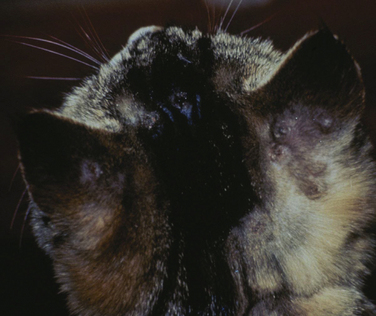Chapter 24 Cowpox virus is a member of the Orthopoxvirus genus within the family Poxviridae, which are large, enveloped, double-stranded DNA viruses.2 Other orthopoxviruses include the viruses of smallpox (now eradicated), vaccinia (the smallpox vaccine), monkeypox (which is endemic to central Africa but was recently introduced to, and eradicated from, North America), and a range of other mammalian orthopoxviruses. All orthopoxviruses are closely related genetically and antigenically; therefore, vaccinia virus can be used to immunize against all orthopoxvirus infections. Cowpox virus has the largest genome of all the orthopoxviruses. Different strains of cowpox virus exist, as determined by both biologic characteristics and nucleotide sequence. Whether these merely reflect geographic variation of the virus (and therefore its main hosts and pathogenicity) or a range of independent virus species is still to be determined. For the purpose of this account, however, they are regarded as a single viral species. Raccoonpox virus is also an orthopoxvirus. Remarkably little is known about its epidemiology, or indeed about the other known North American orthopoxviruses, skunkpox, and volepox viruses, which together form a distinct clade. Raccoonpox virus appears to be fairly host specific but was isolated from a cat with cowpox-like disease in Canada.3 Raccoonpox virus was originally isolated from the lungs of apparently healthy raccoons in the northeastern United States, and serologic surveys in the same area suggested that more than 20% of wild raccoons had antibody to the virus. Experimental infection of raccoons also caused no obvious disease.4 The narrow host range, low zoonotic and pathogenic potential, and endemicity of raccoonpox virus to North America has led to its development as a vector for recombinant vaccines for use in American wildlife species. The parapoxviruses comprise a different genus from the orthopoxviruses in the family Poxviridae. Parapoxviruses are genetically very similar to each other (but significantly different antigenically and genetically from the orthopoxviruses), and differentiation of individual species is difficult.5 Parapoxvirus infections have been described in cats in several countries, and when characterized, the causative virus has been shown to be orf virus.6 Orf occurs worldwide, mainly in sheep and goats, and is readily transmissible to human beings. The signs of cowpox vary according to the host species. The classical presentation in cats is of a primary skin lesion, often with secondary bacterial infection, usually on a forelimb or the face, thought to arise from the inoculation of virus into a wound—perhaps a bite wound—while hunting infected wild rodents. In some cases, severe necrotizing facial dermatitis develops. The primary lesion may be followed by lethargy and possibly pyrexia for up to 10 days, after which multifocal skin lesions appear. These first develop as papules (Figure 24-1), which become ulcers up to 1-cm in diameter that crust over and heal over 4 to 6 weeks. This leaves small patches of alopecia until the hair regrows. In cats such as Siamese, the hair can grow back a darker color, and scars are often visible for years in cats if their hair is clipped. Infection of dogs is less common, and in dogs, lesions are usually more localized and the systemic disease much less severe.6–8
Feline Poxvirus Infections
Etiology and Epidemiology
Raccoonpox Virus
Parapoxviruses
Clinical Features
Cowpox Virus
< div class='tao-gold-member'>
![]()
Stay updated, free articles. Join our Telegram channel

Full access? Get Clinical Tree


Feline Poxvirus Infections
Only gold members can continue reading. Log In or Register to continue

